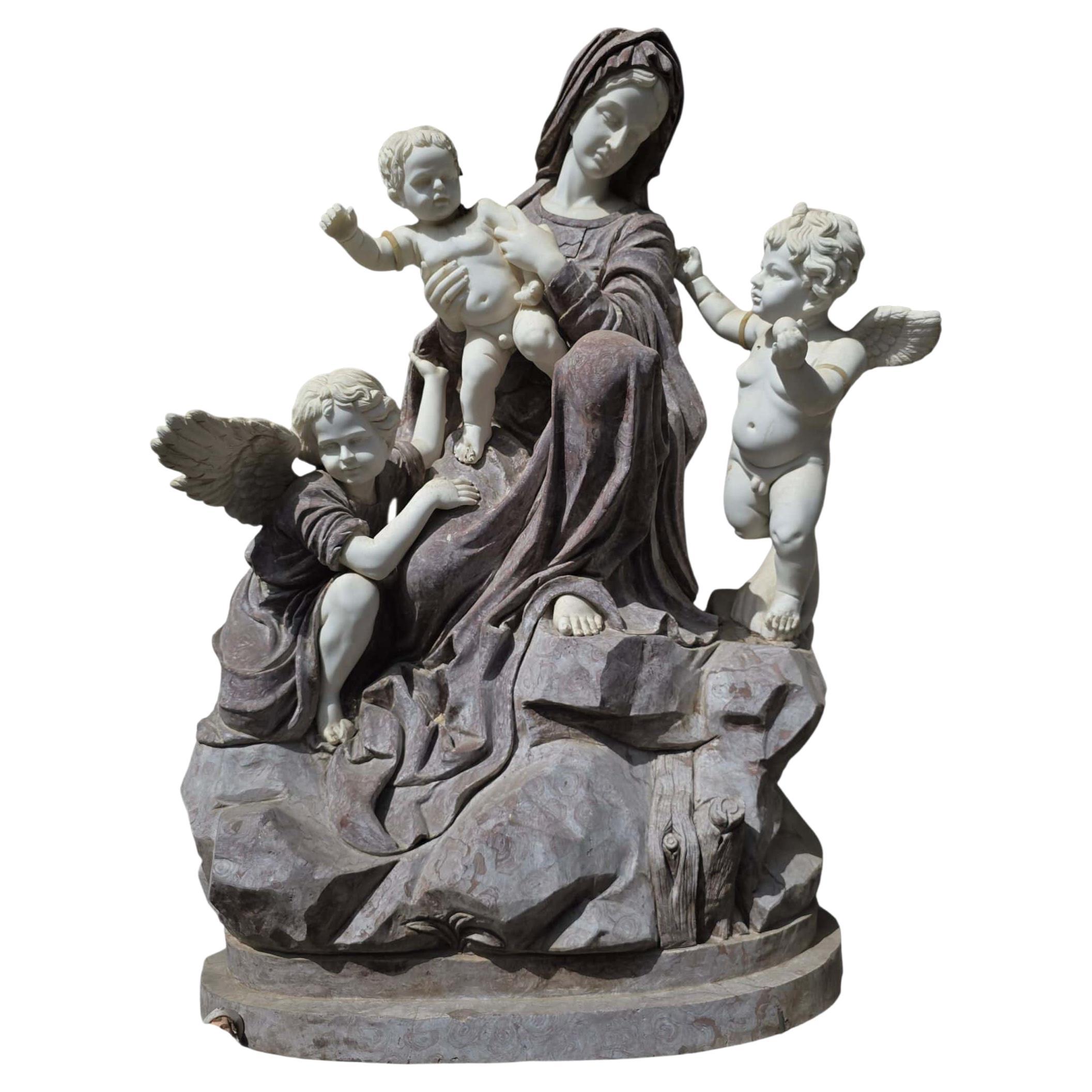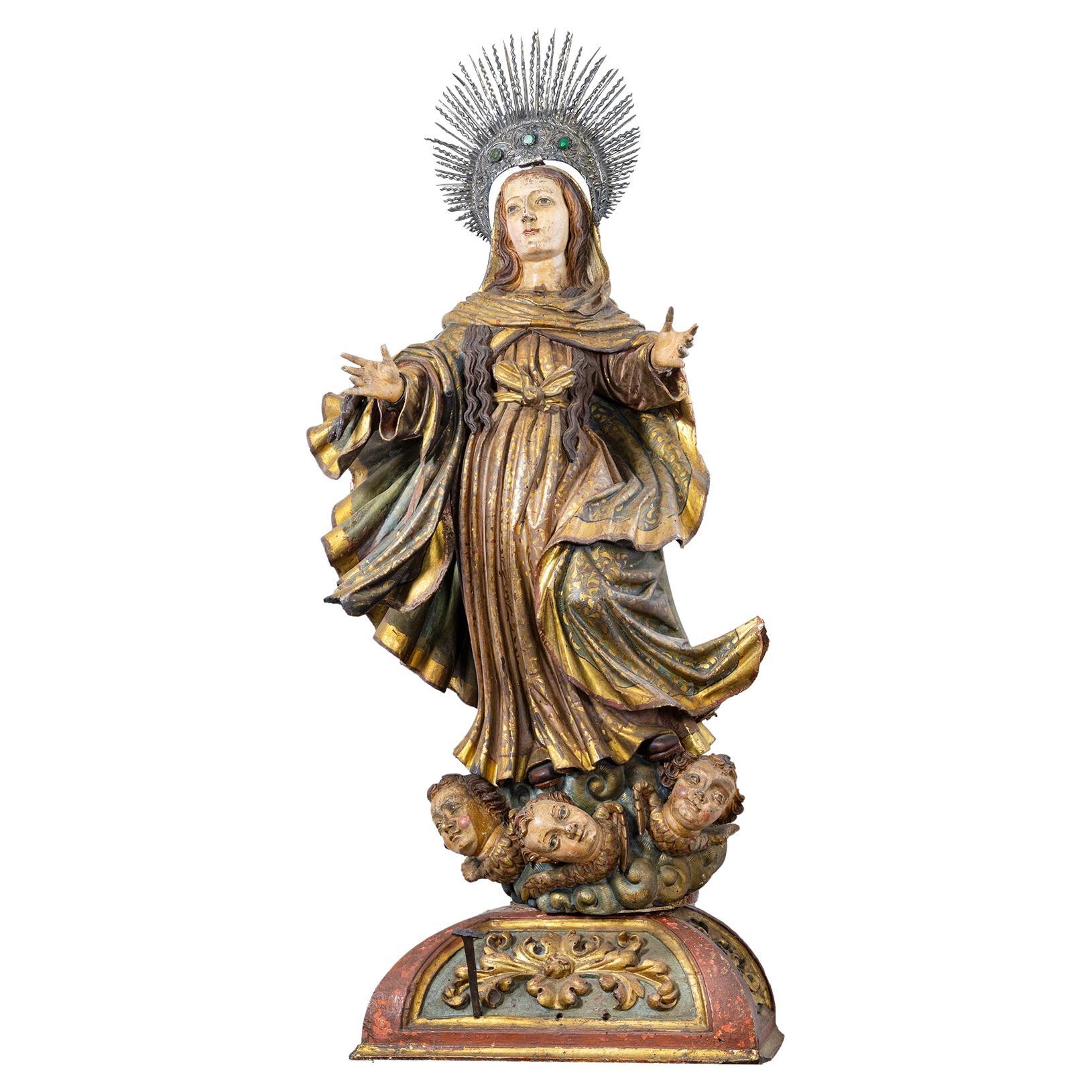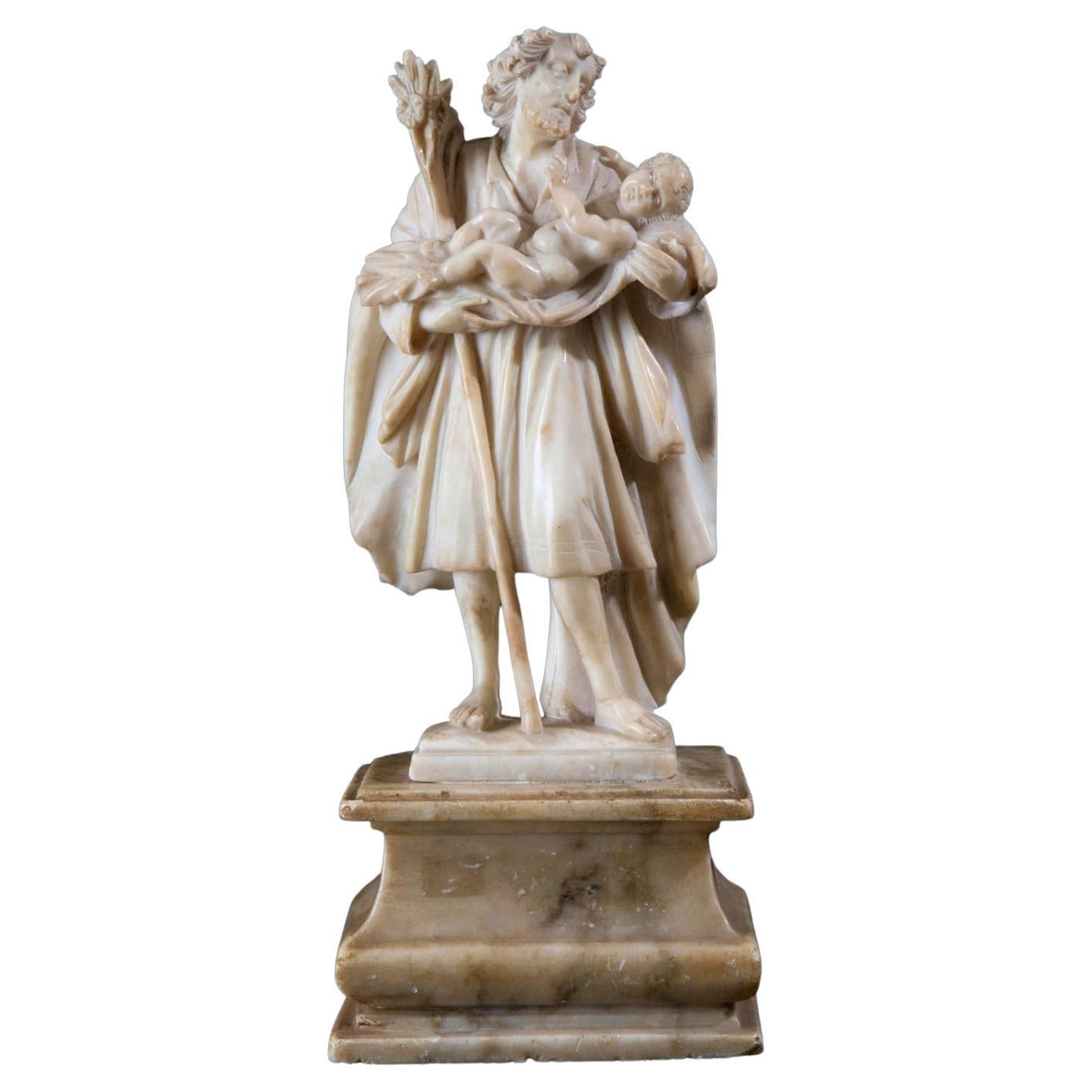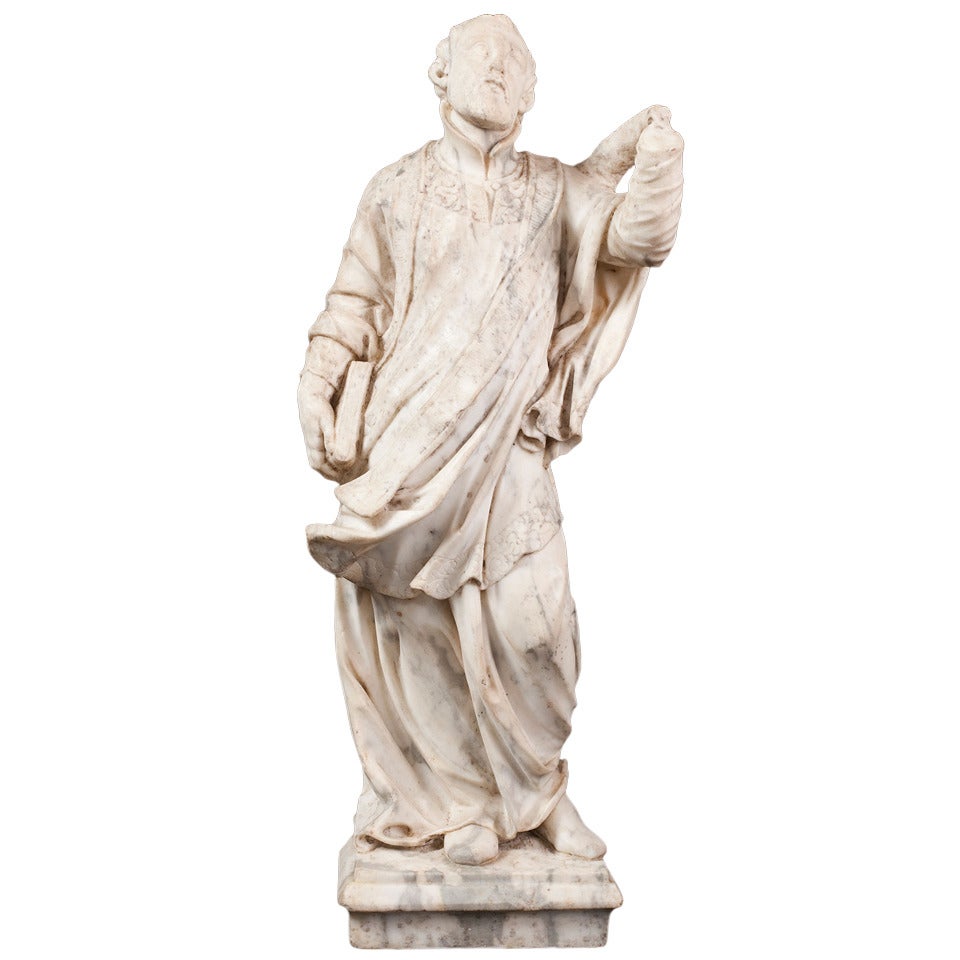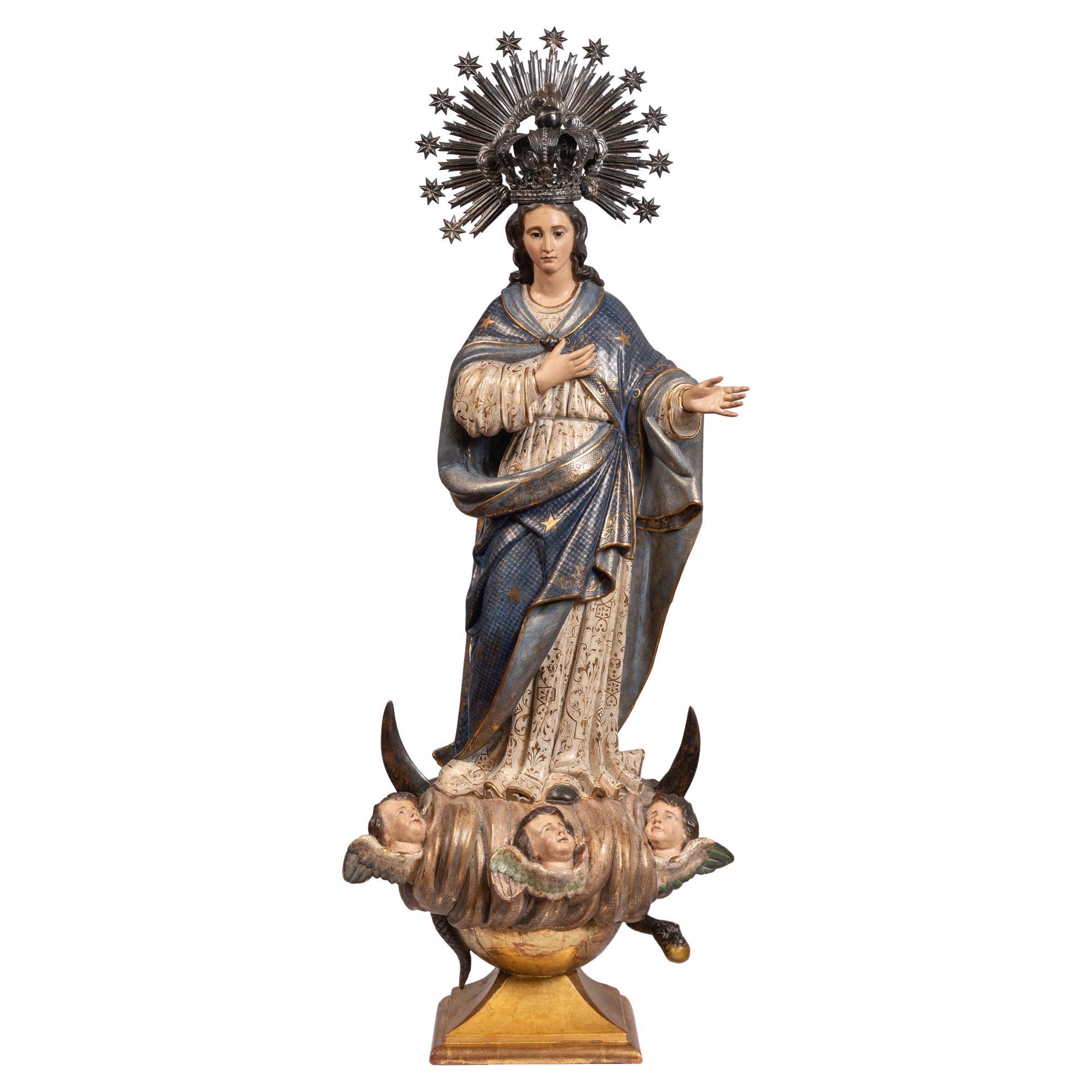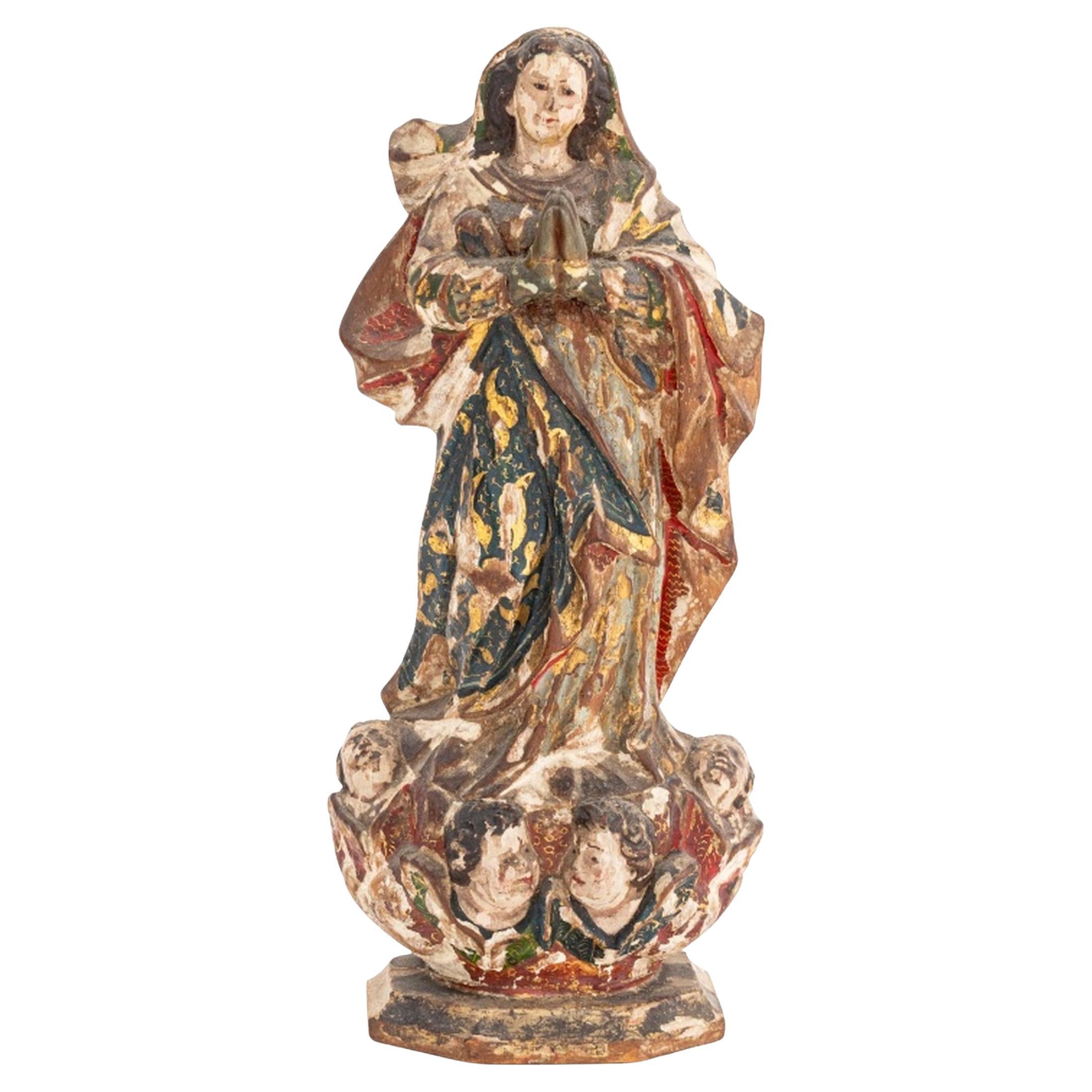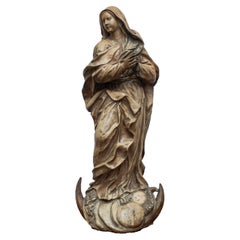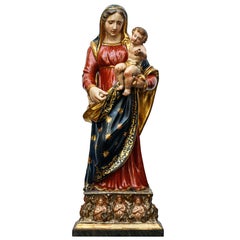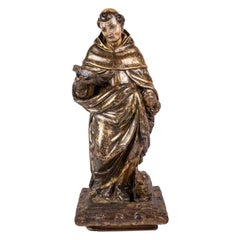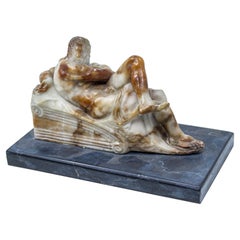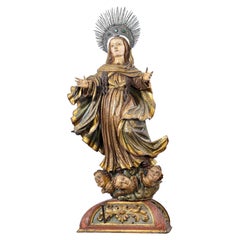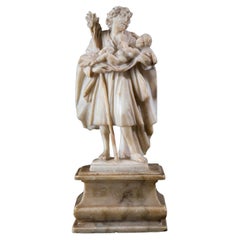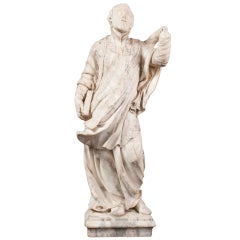Items Similar to 18th Century Immaculate Conception with Saints Sculpture Marble
Want more images or videos?
Request additional images or videos from the seller
1 of 7
18th Century Immaculate Conception with Saints Sculpture Marble
$4,549.46
£3,375.72
€3,800
CA$6,354
A$6,891.06
CHF 3,619.45
MX$83,704.08
NOK 45,291.65
SEK 42,644.62
DKK 28,937.02
About the Item
18th century
Immaculate Conception and saints
Marble, 60 x 50 x 9 cm
In the center of the marble oval we find an Immaculate Conception accompanied by St. Vincent Ferrer (identifiable thanks to the presence of the wings and the Dominican dress), and by two saints of difficult identification, one of them with a monastic habit.
The theme of the Immaculate Conception began to appear in artistic works ever since the debate began, which saw the Franciscans and the ramifications of the Benedictine Order lined up on one side, linked to the thought of Anselmo d'Aosta and Bonaventura da Bagnoregio, and on the other the Dominicans, linked to the discussion offered by Thomas Aquinas.
Even if the Catholic dogma will actually exist only in 1854, with the proclamation by Pius IX. It is a hot topic and was for centuries the subject of theological disputes: the thought that Mary was, from the moment of conception, free from sin was in contrast with the words of Christ whose affirmation that no man is born without blemish. Over the centuries, Mary has been promoted as a vehicle for the incarnation of her son, therefore also Immaculate and Most Pure, because she alone was born without original sin and conceived without concupiscence.
In art, the theme was initially approached by gothic artists in a "cryptic" way, where the conclusion was sent back to the viewer, perhaps putting a series of easily decodable symbols and metaphors.
It was difficult to fix an iconography for such an abstract concept. From the fifteenth century the works of art became more evident, leaning towards one or the other hypothesis, well understood by the reading of elements that clarify the divine intervention in certain episodes of the life of Anna and Joachim and of the infancy of the Virgin. More courageous were the works linked to the theme of the Dispute on the Immaculate Conception, where the artists portrayed, a more unique than rare case in sacred art, the contrasting opinion of the doctors of the Church.
With the Counter-Reformation, the fixed iconography linked to the concept of the Immaculate Conception was established, which will be the one ratified by dogma. Mary appears as a new Eve as she tramples the serpent symbol of sin, represented as a young woman with joined hands, often accompanied by a crescent moon symbol of chastity, and the Franciscan cord with three knots.
- Dimensions:Height: 23.63 in (60 cm)Width: 19.69 in (50 cm)Depth: 3.55 in (9 cm)
- Materials and Techniques:
- Place of Origin:
- Period:
- Date of Manufacture:18th Century
- Condition:Wear consistent with age and use.
- Seller Location:Milan, IT
- Reference Number:1stDibs: LU5918229642252
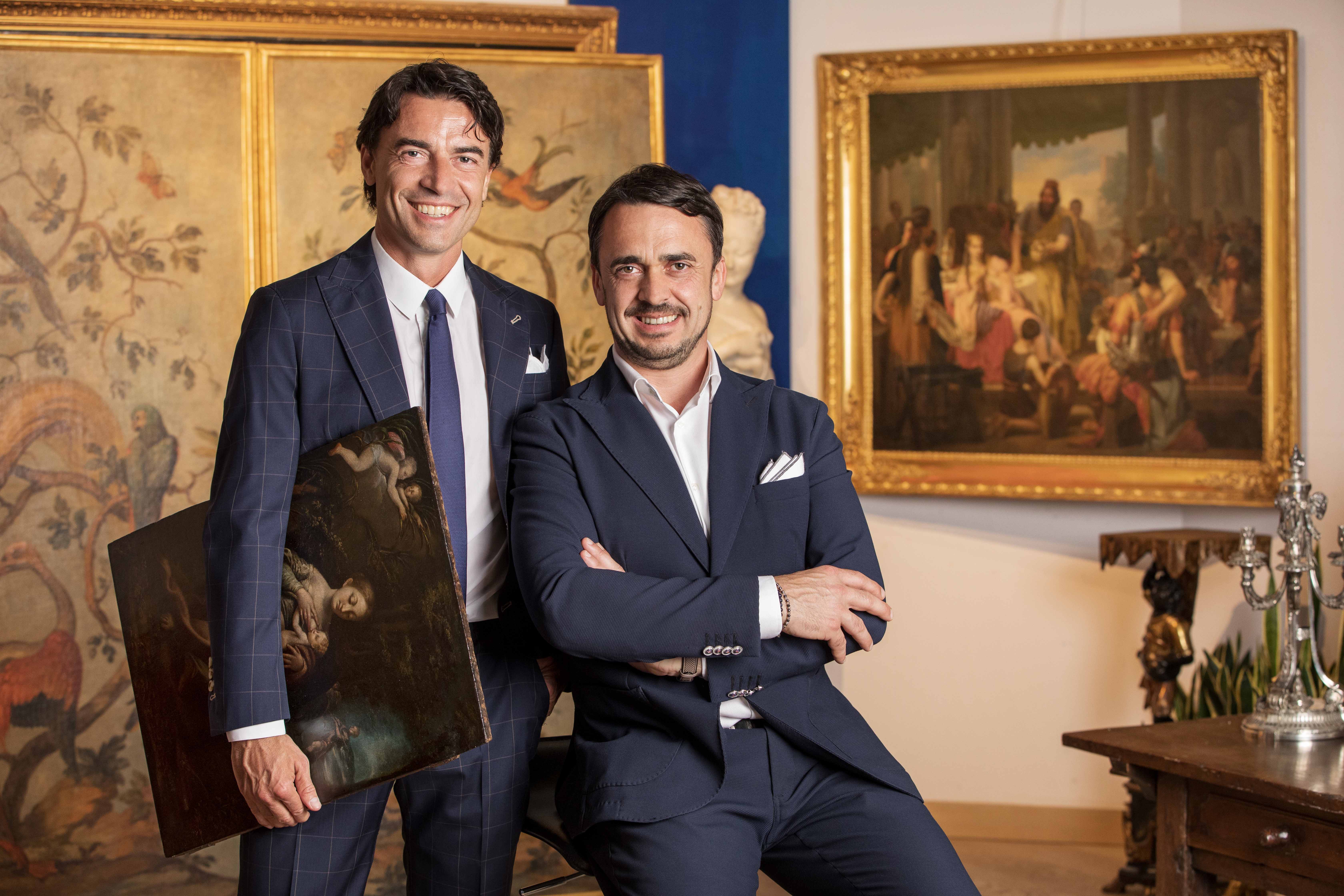
About the Seller
5.0
Vetted Professional Seller
Every seller passes strict standards for authenticity and reliability
Established in 2000
1stDibs seller since 2021
30 sales on 1stDibs
- ShippingRetrieving quote...Shipping from: Milan, Italy
- Return Policy
Authenticity Guarantee
In the unlikely event there’s an issue with an item’s authenticity, contact us within 1 year for a full refund. DetailsMoney-Back Guarantee
If your item is not as described, is damaged in transit, or does not arrive, contact us within 7 days for a full refund. Details24-Hour Cancellation
You have a 24-hour grace period in which to reconsider your purchase, with no questions asked.Vetted Professional Sellers
Our world-class sellers must adhere to strict standards for service and quality, maintaining the integrity of our listings.Price-Match Guarantee
If you find that a seller listed the same item for a lower price elsewhere, we’ll match it.Trusted Global Delivery
Our best-in-class carrier network provides specialized shipping options worldwide, including custom delivery.More From This Seller
View All18th Century Immaculate Madonna Terracotta Sculpture
Located in Milan, IT
18th century
Immaculate Madonna
Terracotta, 53 x 22 x 20 cm
The work examined depicts the Virgin Mary treated according to the iconography of the Immaculate Virgin
The theme of the Immaculate Conception began to appear in artistic works ever since the debate began, which saw the Franciscans and the ramifications of the Benedictine Order lined up on one side, linked to the thought of Anselmo d'Aosta and Bonaventura da Bagnoregio, and on the other the Dominicans, linked to the discussion offered by Thomas Aquinas...
Category
Antique 18th Century European Figurative Sculptures
Materials
Terracotta
19th Century Madonna and Child with Souls in Purgatory Papier-Mache Sculpture
Located in Milan, IT
First half of the 19th century
Madonna and Child with souls in Purgatory
Lacquered and gilded papier-mache with polychrome wooden base
cm 96.5 x 37.5 x 28
"At that time I asked the Lord Jesus: 'For whom do I still have to pray?'. Jesus answered me that the following night he would make me known for whom I had to pray. I saw the Custodian Angel, who ordered me to follow him. At a moment I found myself in a foggy place, invaded by fire and, in it, a huge crowd of suffering souls. These souls pray with great fervour, but without effectiveness for themselves: only we can help them. The flames that burned them, they did not touch me. My Guardian Angel did not abandon me for a moment. And I asked those souls what their greatest torment was. And they unanimously answered me that their greatest torment is the ardent desire of God. I read the Madonna who visited the souls of Purgatory. The souls call Mary 'Star of the Sea'. She brings them refreshment ".
(Diary of Sister Faustina Kowalska p. 11)
A Polish religious, Saint Faustina Kowalska (1905-1938) reinterpreted in the pages of her testimony the ancient role of the Virgin as savior and supporter of the souls of Purgatory. The Second Vatican Ecumenical Council established that, assumed into Heaven, the Mother of God should operate a continuous intercession in favor of those children waiting for Paradise who were in the place, quoted for the first time by Pope Gregory the Great...
Category
Antique Early 19th Century Italian Figurative Sculptures
Materials
Paper
18th Century Sant'antonio Abate Sculpture in Wood
Located in Milan, IT
18th Century
Sant’Antonio Abate
Wood, cm alt. 61
Base 25 x 17.5 cm
This wooden sculpture depicts Sant’Antoni Abate. Antonio was born in Come i...
Category
Antique 18th Century Italian Figurative Sculptures
Materials
Wood
18th Century Personification of the Day Alabaster Sculpture
By Michelangelo Buonarroti
Located in Milan, IT
18th century
Personification of the Day
Alabaster, cm 11.5 x 17.5 x 5
With base cm 14.5 x 20,8 x 11.7
Il Giorno is a marble sculpture (160x150 cm) that Michelangelo mad...
Category
Antique 18th Century Figurative Sculptures
Materials
Alabaster
17th Century Madonna with Child from the Impruneta Tondo Polychrome Terracotta
Located in Milan, IT
Tuscan school, 17th century
Madonna with Child - from the Impruneta Tondo
Measures: Polychrome terracotta, 65 x 46 x 10 cm
This polychrome terracotta relief, gently jutting...
Category
Antique 17th Century Italian Abstract Sculptures
Materials
Terracotta
19th century, from Sassoferrato, Madonna Orante
Located in Milan, IT
19th century, by Giovanni Battista Salvi, known as Sassoferrato (Sassoferrato, 1609 - Rome, 1685)
Praying Madonna
Oil on canvas, 44 x 54 cm
Framed, 88 x 60 cm
Giovanni Battista S...
Category
Antique 19th Century Italian Other Paintings
Materials
Canvas
You May Also Like
Monumental Italian Marble Sculpture of the Virgin Mary with Cherubs, 20th Centur
Located in Madrid, ES
Magnificent Italian sculpture of the Virgin Mary surrounded by cherubs, carved in the 20th century from fine multicolored marble. Executed with exceptional craftsmanship, the composi...
Category
Vintage 1980s Figurative Sculptures
Materials
Marble
$29,959 Sale Price
20% Off
Immaculate Conception Religious Sculpture, Baroque, 18th Century
Located in Lisbon, PT
An exceptional 18th-century Spanish Baroque sculpture of the Immaculate Conception, carved in chestnut wood and richly polychromed and crowned.
The sculpture retains its vibrant pi...
Category
Antique 18th Century Spanish Baroque Figurative Sculptures
Materials
Brass, Gold Leaf
$36,829 Sale Price
30% Off
Marble Sculpture Depicting "Saint Cristofer" 18th Century
Located in Madrid, ES
Marble sculpture depicting "Saint Cristofer" 18th century
Marble base.
Some defects
Good condition for the age
Measures: 36 x 14 x 7 cm.
Category
Antique Early 18th Century Italian Baroque Busts
Materials
Carrara Marble
Marble Sculpture of a Saint, Late 17th Century
Located in CH
A late 17th century marble sculpture of a saint, possibly Central Italian. Monogrammed on the marble base "F G F."
Category
Antique Late 17th Century Italian Baroque Sculptures
Materials
Marble
18th Century Spanish Virgin Mary of Immaculate Conception, Handcrafted Sculpture
Located in Madrid, ES
Completely hand-crafted in 18th century Spain, this sculpture of the Virgin stands 1.5 meters / 5 feet tall and was most certainly created for devotional purposes, to be displayed in a church or chapel.
Besides its impressive size this sculpture is an excellent, museum-quality example of the Spanish “Estofado” polychrome technique, developed during the Gothic period to imitate rich brocade fabrics. The finely carved “fabric” areas of the sculpture would be first covered in gesso, and then a layer of gold leaf would be applied. The gold leaf would then be painted over with various colors of tempera paints. Once dry, the painted surface would be incised or scratched away in patterns, revealing the gold beneath.
The sculpture was professionally restored in 2022 by a firm that is often hired by the Spanish government to work on historic building interiors and museum pieces. The virgin was carefully cleaned, repaired and its condition stabilized. A complete and fully-illustrated restoration report will be included with purchase.
Often confused with the virgin birth of Jesus, the belief that the Blessed Virgin Mary herself was conceived “immaculately” without original sin has been variously defended and debated within the Catholic Church since the pre-Middle Ages. For centuries, artists struggled to create an acceptable visual representation of this highly abstract concept, in part taking inspiration from the Book of Revelation and other scriptural sources.
We see the Virgin standing on a half moon (biblically inspired, though also an ancient symbol of chastity) with her long natural hair loose down her back, another indication of purity. Both her white tunic and flowing blue mantle...
Category
Antique 18th Century Spanish Baroque Figurative Sculptures
Materials
Silver, Gold Leaf
Our Lady of Immaculate Conception Sculpture
Located in Astoria, NY
Our Lady of Immaculate Conception Polychrome Painted and Carved Wood Sculpture, 19th century, with hand-painted gilt accents. 9.25" H x 4" W x 2.75" D. Provenance: From a Greenwich, ...
Category
Antique 19th Century Religious Items
Materials
Wood
More Ways To Browse
Immaculate Conception
Eve Serpent
Thomas Aquinas
South Africa Art Sculpture
Art Deco Glass Figurine
Balinese Wood
Bisque Sculpture
Bronze Faun
Bronze Musician
Male Statue
Metal Dancers Sculpture
Mushroom Objects
Nude Female Torso
Nymphs Nude
Alabaster Statues
Bronze Face Sculpture
Bronze Sculpture Andre
Ceramic Pumpkin
